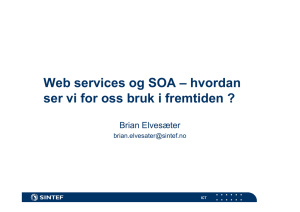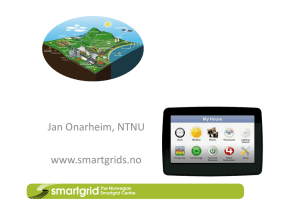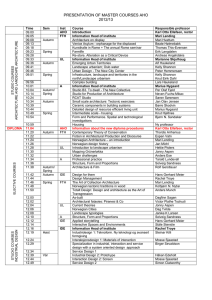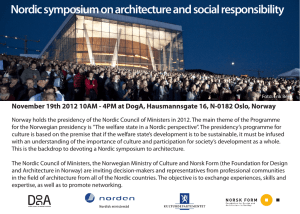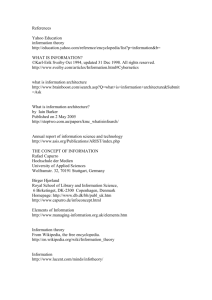Web Services og SOA – hvordan Brian Elvesæter
advertisement
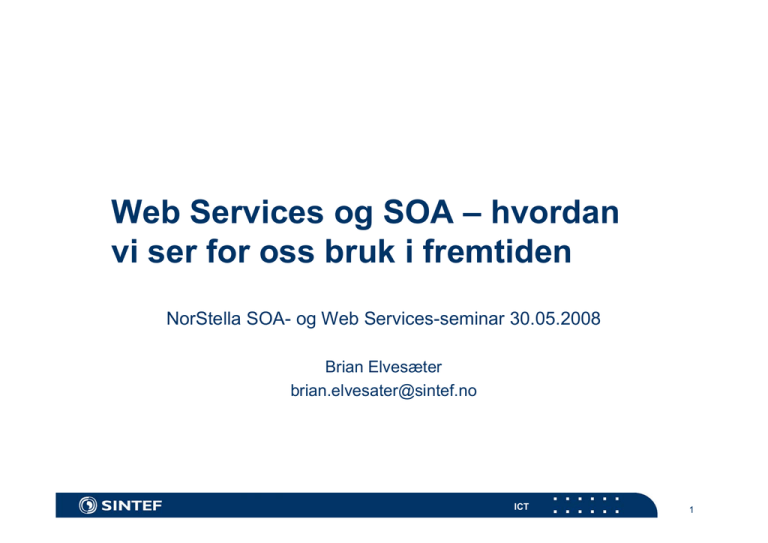
Web Services og SOA – hvordan vi ser for oss bruk i fremtiden NorStella SOA- og Web Services-seminar 30.05.2008 Brian Elvesæter brian.elvesater@sintef.no ICT 1 Outline Service-oriented architecture (SOA) Interoperabilitet og systemintegrasjon (Semantic) Web services Forskning og utvikling på SOA ICT 2 Service-oriented architecture (SOA) ICT 3 Different kinds of architectures Enterprise architecture Business architecture Conceptual architecture Integration architecture Architecture framework Knowledge architecture Serviceoriented architecture Realisation architecture Functional architecture ICT architecture Logical architecture Information architecture Web services architecture ICT 4 EA – SOA – WSA Enterprise architecture (EA) is the practice of applying a method for describing a current and/or future structure and behaviour for an organization's processes, information systems, personnel and organizational sub-units, so that they align with the organization's core goals and strategic direction. Holistic view of the enterprise and all its important assets. Service-oriented architecture (SOA) is a paradigm for organizing and utilizing distributed capabilities that may be under the control of different ownership domains. [OASIS 2006] Architectural style for designing (technical) systems. Web services architecture (WSA) intends to provide a common definition for understanding Web services. A Web services architecture involves many layered and interrelated technologies. [W3C 2004] A set of enabling Web technologies for implementing software systems. ICT 5 SOA governance with EA Architecture is a strategic tool not just high-level design Architecture goes beyond ICT Enterprise architecture is a key component of the IT governance process at any organization of significant size. Stability and flexibility Seem to be contradictory, but a good architecture facilitates change! Communication with stakeholders architects, managers, customers, engineers, … Analysis Enterprise Architecture (EA) is a generic, abstracted and aggregated representation of the core structures and competences of an enterprise. EA supports laying out the main characteristics of the enterprise to be analysed and agreed before detailed technical design is started. It is shared and discussed enterprise-wide between all stakeholders as a common description forms, functions and features, components, properties and relationships. impact-of-change cost and performance ICT 6 Role of enterprise architecture Mission Vision Strategy Goals as is enterprise architecture Actions to be culture leadership domain/aspect architectures products processes people Operations … people IT Mark Lankhorst et al., "Enterprise Architecture at Work: Modelling, Communication and Analysis", Springer, 2005, ISBN: 978-3-540-24371-7. ICT 7 Describing coherence Information architecture Product architecture ? Process architecture ? ? ? Application architecture Technical architecture ? Mark Lankhorst et al., "Enterprise Architecture at Work: Modelling, Communication and Analysis", Springer, 2005, ISBN: 978-3-540-24371-7. ICT 8 OASIS Reference Model for Service Oriented Architecture 1.0 OASIS http://www.oasis-open.org/home/index.php Abstract framework. Understanding significant entities and relationships between them within a service-oriented environment. Development of consistent standards or specifications supporting serviceoriented environment. Based on unifying concepts of SOA and may be used by architects developing specific service-oriented architectures in training and explaining SOA. Reference model not directly tied to any standards, technologies or other concrete implementation details Provide a common semantics that can be used unambiguously across and between different implementations. The reference model focuses on the field of software architecture. ICT 9 What is an SOA Service-oriented architecture (SOA) is a paradigm for organizing and utilizing distributed capabilities that may be under the control of different ownership domains. Visibility, interaction, and effect are key concepts for describing the SOA paradigm. Visibility refers to the capacity for those with needs and those with capabilities to be able to see each other. Whereas visibility introduces the possibilities for matching needs to capabilities (and vice versa), interaction is the activity of using a capability. The purpose of using a capability is to realize one or more real world effects. At its core, an interaction is “an act” as opposed to “an object” and the result of an interaction is an effect (or a set/series of effects). ICT 10 Interoperabilitet og systemintegrasjon ICT 11 Rationale for interoperability Interoperability is the key to increase competitiveness of enterprises. “Enterprise systems and applications need to be interoperable to achieve seamless operational and business interaction, and create networked organizations” – European Group for Research on Interoperability, 2002 Application integration license revenue System implementation budget Misc. 20% B$ Integration 40% Hardware 10% Imp. Services 20% Software 10% The cost of non-interoperability are estimated to (Source: the Yankee Group 2001) 40% of enterprises IT budget. ICT 12 Holistic approach to interoperability Enterprise A Enterprise B Application ICT Knowledge Application Data Data Semantics Knowledge Business Semantics Business Interoperability (def.) is “the ability of two or more systems or components to exchange information and to use the information that has been exchanged” – IEEE Standard Computer Dictionary Communication To achieve meaningful interoperability between enterprises, interoperability must be achieved on all layers: Business layer: business environment and business processes Knowledge layer: organisational roles, skills and competencies of employees and knowledge assets ICT layer: applications, data and communication components Semantics: support mutual understanding on all layers ICT 13 Motivation Enterprise ICT Challenges Business agility Flexibility and adaptability Enterprise architecture frameworks + Holistic approach + Different views of an enterprise as related (visual) knowledge models - Current enterprise architectures are only blueprints Challenges Inflexible and difficult to adapt Enterprise application integration (EAI) Service-oriented architecture (SOA) + Architectural style + Loosely coupled systems + Horizontal integration between different business domains + Use case oriented service composition +/- Web services (enabling technology) Requirements Enterprises require operational enterprise architectures ICT solutions must be designed to be inherently interoperable ICT 14 Integrasjon vs. interoperabilitet Area Integration Interoperability Consistency of objectives Consistency of local objectives to global ones No consistence between local and global objectives Type of coupling Tightly coupled, components interdependent Loosely coupled, components independent Solution approach Uniformisation of languages, methods, tools etc. Network of services with identity and diversity preserved. Organisational structure Intra-enterprise, fusion, restructuration, etc. Inter-enterprise, virtual enterprise, etc. ICT 15 History of integration 1950 – 2007: Integration = develop then integrate 1950s-1970s: Simple, manual integration 1970s-1980s: Distributed Computing Applications (interoperation) Databases (integrate) 1990s: Business Driven Integration – concepts, technologies, and tools – increased automation, internet-based computing Concepts: Workflows, Processes, Web, Integration solutions blossom (diverge): ETL, EAI, BPM, … 2000: SOA Emerges 2000: Web services 2003: Integration solution evolution accelerates, vendor chaos ensues 2005: Growth in all integration categories ICT 16 SOA and integration/interoperability Fundamental change for integration: X <-> Y Pre-SOA: outside, after development Post-SOA: inside, integral part of development / computational model Towards loosely coupled interoperable systems From static composition to (semi)-automated compositions of services Process integration/interoperability Consequences How should integration/interoperability be done? Services under different ownership domains may fail Monitoring and service contracts Innovation and experience Competition, expansion, consolidation ICT 17 Application architecture vs. SOA Segmented business areas a Collaborative business areas b c SOA r x s x y1 y2 Application architecture r a y s b y t c z t z a r b x t c s z z y Service-oriented architecture (SOA) ICT 18 Integration/interoperability in SOA 2007 – 2012: Integration = dominant programming model 2001-2010: Wrapping 2005-2010: Re-Engineering 2006-2008: Consolidation 2006-2008: Research on Semantic SOA 2007-2012: Emergence of SOA Platforms and Solutions 2008-2012: Problem Solving Era: IT/integration relegated to low level function ICT 19 ICT 20 SOA platform consolidation Data and information integration ➪ Information Fabric EII: Enterprise information integration ETL: Extract, transform and load Application integration ➪ Integration Suite EAI: Enterprise application integration B2Bg: Business-to-business gateway ESB: Enterprise service bus Applications and Processes ➪ Business Process Management Suite BPM: Business process management B2Bi: Business-to-business integration Enterprise workplace ➪ Interaction Platform ICT 21 ICT 22 Integration suite services Goal: Composite applications Components: EAI, BPM, B2B, B2Bi Extensions: Adapter, collaboration, analysis, reporting, development, monitoring, contracts, SOA standards, … ICT 23 Business process management suite & interaction services Goal: Continuous process improvement Components: BPM human-centric: people-intensive processes Integration-centric: system-intensive processes ICT 24 Information fabric services Goal: Holistic view of data (information virtualisation) Components: DBMS, EII + ETL + replication Extensions: Distributed meta-data repository, distributed data access, integrated data management ICT 25 (Semantic) Web services ICT 26 The waves of client/server technology First Wave Second Wave Third Wave Fourth Wave Fifth Wave MDA, Web Services, .Net Server-side Distributed Service-oriented componentsc Objects Architecture J2EE/EJB SOAP, XML WEB 2.0 OMG CORBA Semantic COM+ WSDL/WSFL COM/OLE Web Corba Comp Web/Internett Services Agents, P2P Java File Servers FIPA 1982 1986 Sixth Wave 1990 1994 Grid 1998 1999 2000 2001 2002 2004 2007 ICT 27 Web service Web service “Applications identified by a URI, whose interfaces and bindings are capable of being defined, described and discovered as XML artefacts. A Web service supports direct interactions with other software agents using XML-based messages exchanged via Internet-based protocols.” (W3C) http://www.w3.org/ SOA ~ architectural style Web services stack ~ technology/protocol standards SOA =/= Web services ICT 28 Web services architecture Web services can be used to implement serviceoriented solutions They adhere to the set of roles and operations specified by the service oriented model. They have also managed to establish a standardized protocol stack. ICT 29 WS-* stack to-be Simplified version of the to-be WS-* stack Families of related specs not expanded Competing spec families not shown “Historical” or abandoned specs not shown WS-Addressing WS-Notification WSDL SOAP WS-Coordination XML WS-Security BPEL WS-CDL WS-Federation UDDI WS-Policy WS-ReliableMessaging WS-MetadataExchange WS-Resource WS-Transfer ICT 30 WS-* stack as-is Complete version of the as-is WS-* stack The 3 widely-accepted specs today are the same as 5 years ago BPEL and WS-Security is gaining momentum Orchestration, discovery and brokering do not exist in today’s world WS-Addressing WS-Notification WSDL SOAP WS-Coordination XML WS-Security BPEL WS-CDL WS-Federation UDDI WS-Policy WS-ReliableMessaging WS-MetadataExchange WS-Resource WS-Transfer ICT 31 Next Generation of the WWW Dynamic Static UDDI, WSDL, SOAP Semantic Web Services WWW Semantic Web URI, HTML, HTTP RDF, RDF(S), OWL Web Services Syntactic Semantic ICT 32 Semantic Web services Semantic Web & Ontologies ontology languages reasoning infrastructures semantic data integration Semantic Web Services semantic WS annotation SWS technologies: automated discovery, composition, mediation, selection, compatibility analysis automated WS execution Web Services & SOA ICT 33 Goal-driven Web Service Usage Client objective / problem to be solved Discovery client-system interaction Goals discovery, composition, mediation SWS description Composition Mediator combine several WS to solve a Goal ensure that interaction can take place Mediation execution Web Services & Resources Web Service select best candidate / determine a priority list Behavioral Compatibility Semantics / SWS Ontology Selection & Ranking formal objective description find candidate WS to solve a Goal Internet resolve & handle possibly occurring heterogeneities Execution automatically invoke & consume WS to solve a Goal ICT 34 WSMO Web Service Description - complete item description - quality aspects - Web Service Management - Advertising of Web Service - Support for WS Discovery Non-functional Properties Capability DC + QoS + Version + financial functional description client-service interaction interface for consuming WS - external visible behavior - communication structure - ‘grounding’ Web Service Implementation WS WS (not of interest in Web Service Description) WS realization of functionality by aggregation - functional decomposition - WS composition Choreography --- Service Interfaces --- Orchestration ICT 35 WSMX Detailed Architecture System Interface Adapter 2 ... Adapter n Data and Communication Protocols Adapters Adapter 1 36 ICT Forskning og utvikling på SOA ICT 37 Trends Model-driven architecture (MDA) Mer utstrakt bruk av modeller Kombinasjon av ulike formalismer (DSLer) for å beskrive ulike aspekter av IT-arkitektur/system Standardisering av service metamodel (UPMS) Konsolidering av SOA-plattformer Semantiske teknologier Semantic Web services Rikere portalteknologi og tjenester ut mot sluttbrukere Rikere brukergrensesnitt Sluttbrukere vil ha anledning til å sette sammen egne tjenester Tjeneste-paradigme for å levere/tilby programvare Ser på Weben som en plattform i seg selv Software-as-a-Service (SaaS) Software-as-a-Service Utility (SaaSU) ICT 38 Forskningsaktiviteter COIN (Enterprise Collaboration and Interoperability) EU-prosjekt med fokus på utvikling av open-source Enterprise Collaboration (EC) og Enterprise Interoperability (EI) services http://www.coin-ip.eu/ SHAPE (Semantically-enabled Heterogeneous Service Architecture and Platforms Engineering) EU-prosjekt med fokus på utvikling av modell-baserte verktøy og metoder for tjenesteorienterte arkitekturer http://www.shape-project.eu/ NESSI (Networked European Software and Services Initiative) Europeisk teknologiplattform for SOA http://www.nessi-europe.com/Nessi/ SOA i praksis Norsk ressursnettverk om SOA http://set.sintef.no/soaipraksis/ ICT 39 COIN main objectives 1. To design and develop a pervasive, adaptive service platform to host Baseline and Innovative COIN services for EI and EC and make them available under innovative ondemand, utility-oriented business models (i.e. the SaaS-U model) to European enterprises (and SMEs in particular) for running their business in a secure, reliable and efficient way. 2. To consolidate and stabilize the ICT results of both EC and EI FP6 research into some Baseline Services which constitute the service foundations for COIN. 3. To further enlarge, extend and improve the Baseline Services, by developing other more Innovative Services in the EC and EI fields, which could take into account the most recent and promising technology challenges (in the field of Web 2.0, semantic web, space computing) and put them at service of EC and EI purposes. 4. To represent a pathway to convergence for these two fundamental research streams: EI and EC, by integrating in the same project the most prominent stakeholders of the two research fields coming both from industry and from universities and research centers. 5. To demonstrate, experiment, trial and assess the project results into realistic industrial scenarios offered by our 6 test cases in Aeronautics (Aeronautic Cluster of Andalusia, Spain), Automotive (the Automotive Cluster of Slovenia), Aerospace (the Lazio Connect virtual enterprise network Italy), Pulp & Paper (the Poyry consultancy service providers), Healthcare (the VEN network in U.K.) and ICT (the Hungarian Association of ICT companies). ICT 40 UPMS standardisering i SHAPE UML Profile and Metamodel for Services (UPMS) Flexible Business Models Web Services Service Variability support the activities of service modelling and design fit into an overall model-driven development approach Grid UPMS Agents platform independent modelling requirements for service- oriented architectures P2P Semantic Web Services Heterogeneous Platforms specification of systems of services specification of individual service interfaces specification of service implementations specification of service contract ... ICT 41 UPMS metamodel overview ICT 42 UPMS service metamodel (abstract syntax) ICT 43 UPMS service model example (concrete syntax) ICT 44 NESSI Open Framework (NEXOF) The overall ambition of NESSI is to deliver NEXOF, a coherent and consistent open service framework leveraging research in the area of service-based systems to consolidate and trigger innovation in service-oriented economies. NEXOF consists of three core elements: NESSI Open Reference Model includes the conceptual model of the core elements that enable service-based ecosystems and their relationship as well as underlying rules, principles and policies which lead to interoperable implementations. Core elements include business dynamics, development environment and operational environment. NESSI Open Reference Architecture addressing definition and selection of innovative architectural styles and patterns based on the reference model. Aims to be a standardized open reference architecture for services and components, and also to some extent processes which corresponds to a significant advancement of today’s service-oriented architectures. This will include the definition of the infrastructure requirements. NESSI Open Reference Implementation taking the responsibility to deliver to the community at large with the implementation of the NEXOF concepts and approaches where the openness, built on open source and open standards. ICT 45 SOA i praksis SOA i praksis-nettverket er tverrfaglig sammensatt av brukermiljøer, kunnskapsmiljøer innen virksomhetsmodellering og -analyse, programvaremiljøer, SOA-miljøer, internasjonale IT-leverandører og representanter for nasjonal og internasjonal infrastruktur for både offentlige og private virksomheter. Ressursnettverket har følgende målsettinger: Etablere status og identifiser SOA beste praksis basert på case-analyser. Etablere basis for å utnytte resultater fra pågående SOA-forskning, gjennom formidling av SOA problemstillinger, forskningsresultater og innovasjon (for EU og norske prosjekter). Definere nasjonale forsknings utfordringer innen "SOA i praksis" i forhold til temaet kommuniserende organisasjoner. Generere prosjekter– i form av søknader til VERDIKT samt EU og andre finansieringskilder. ICT 46 Spørsmål? ICT 47
